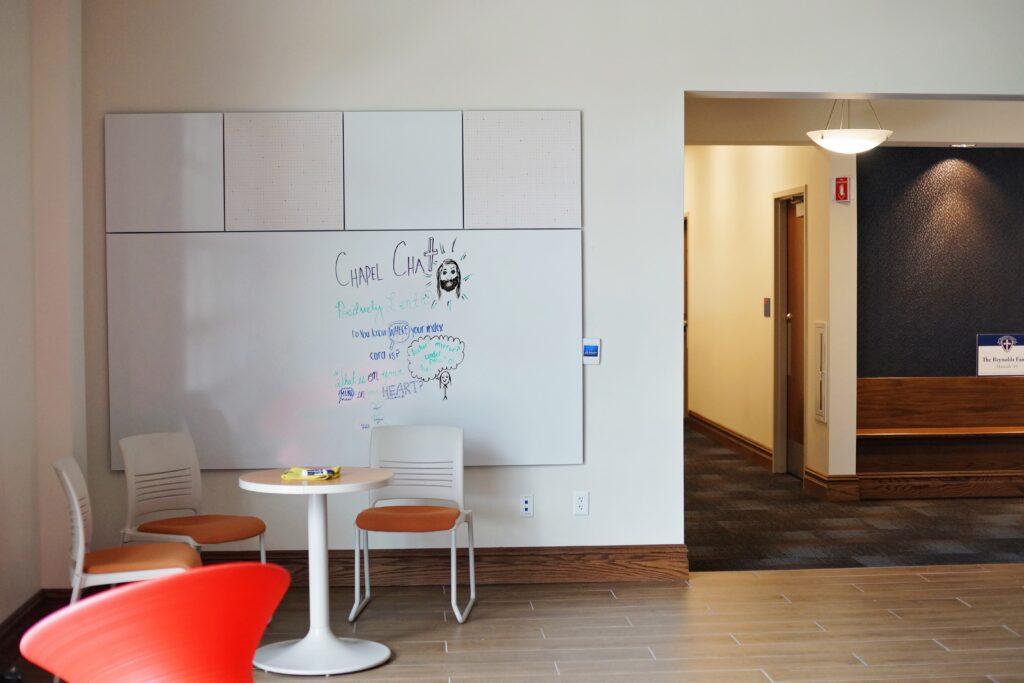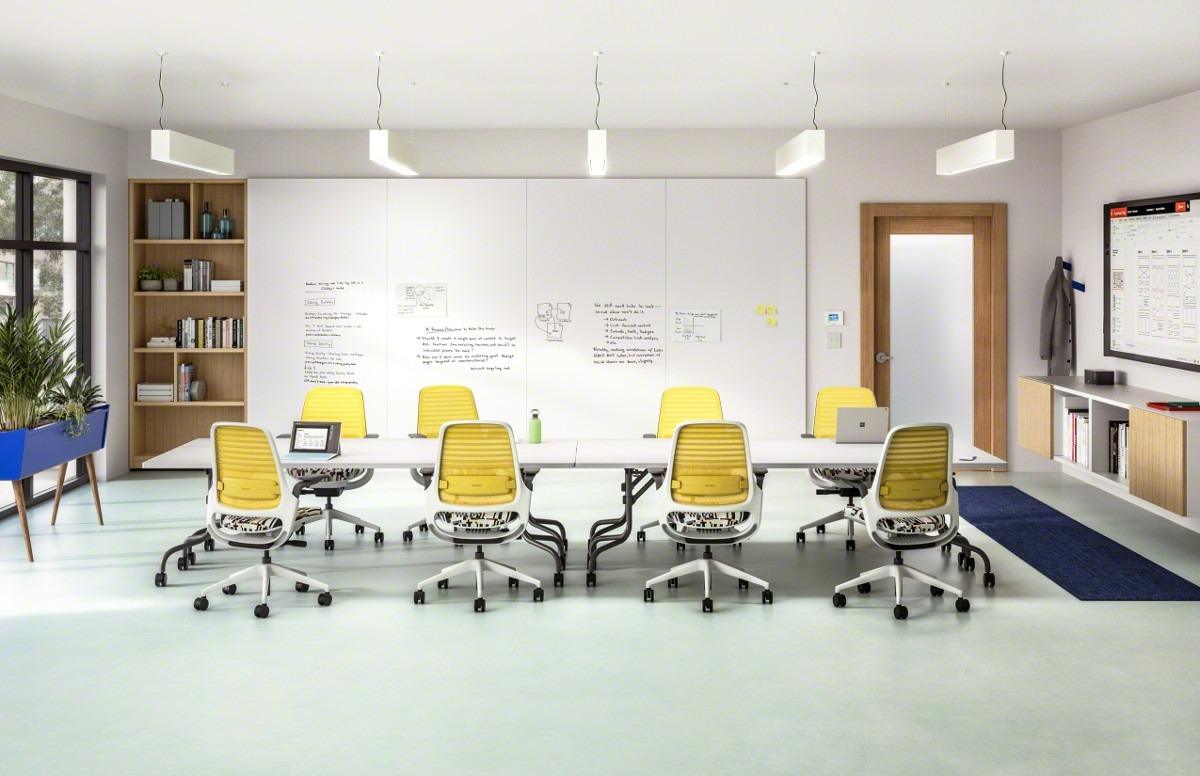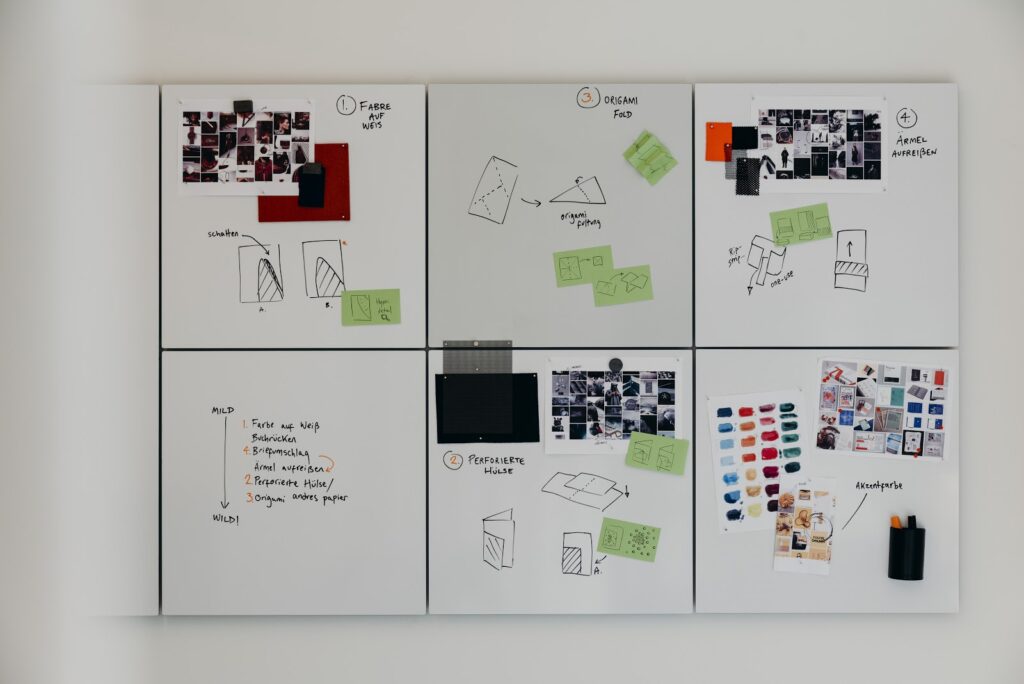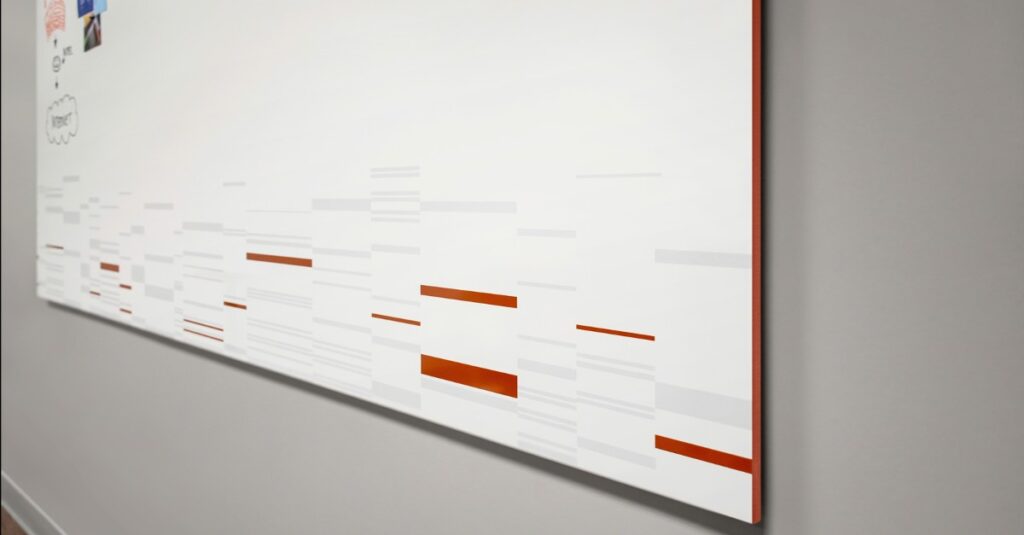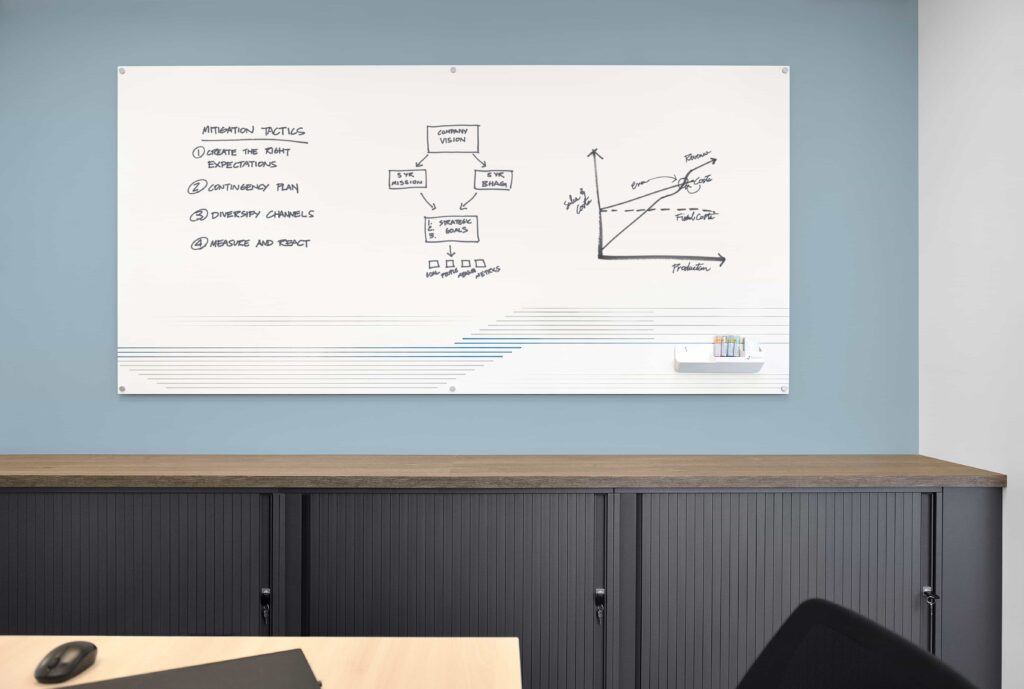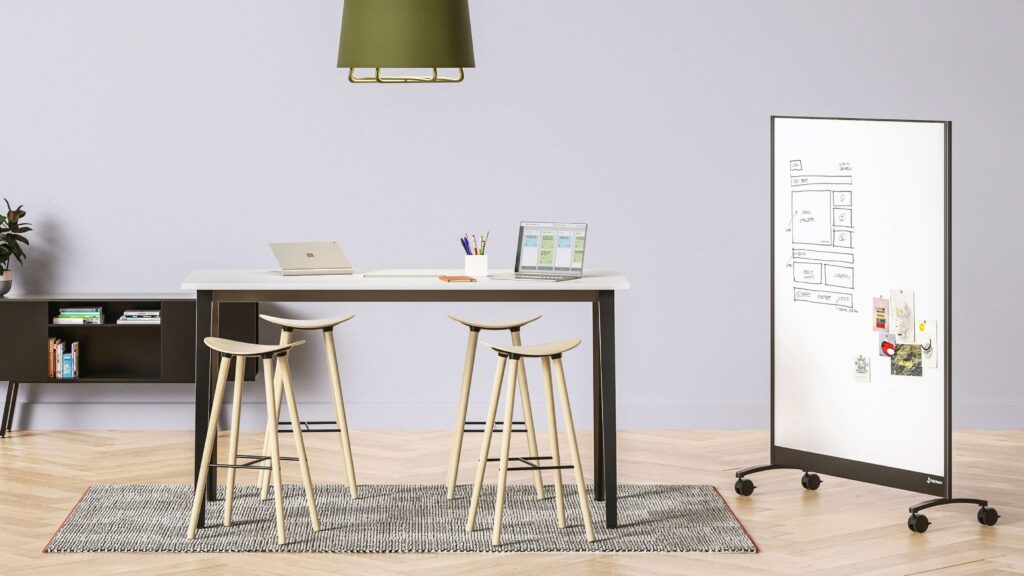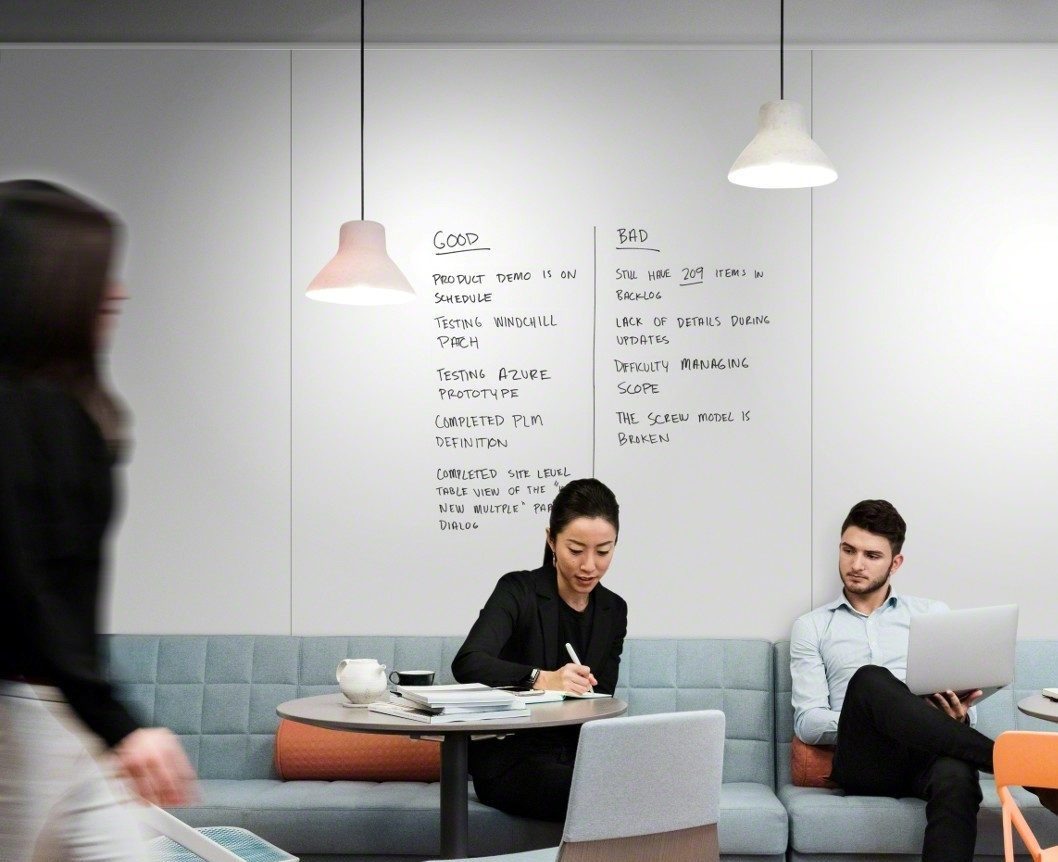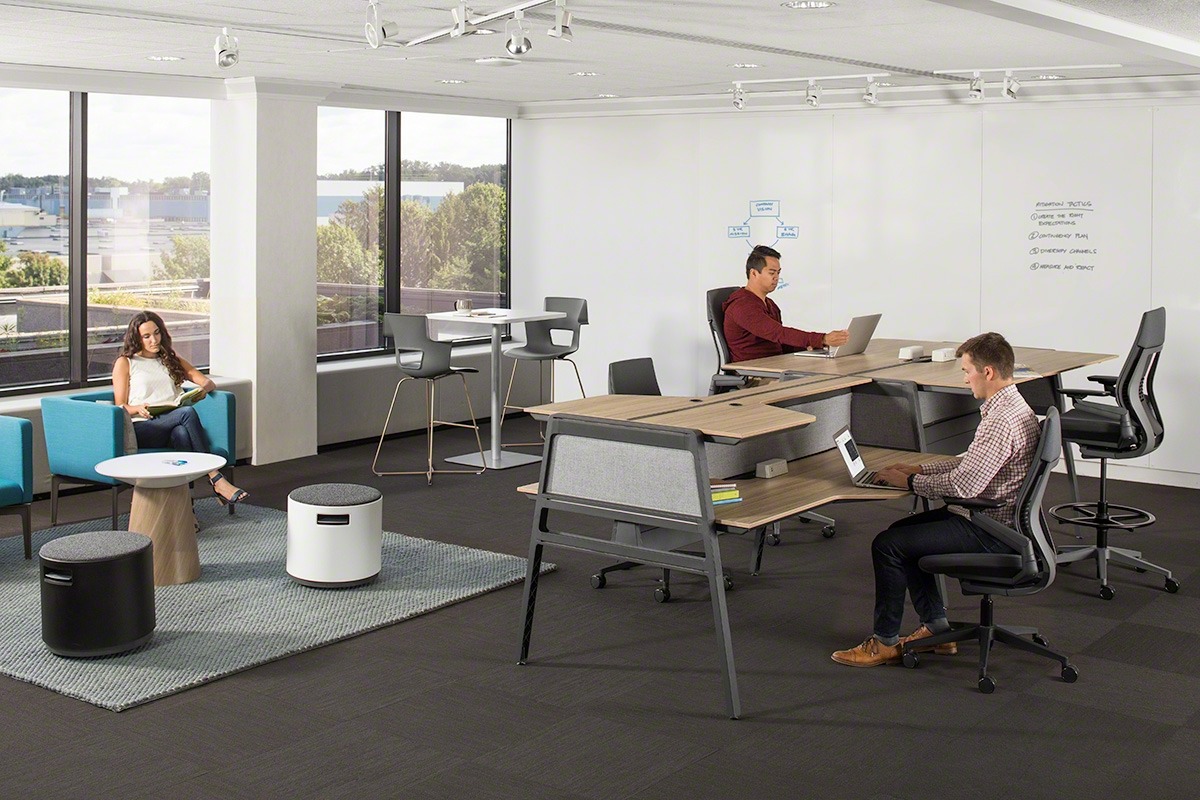Today, the workplace is tasked with meeting a wide range of demands. It must attract and retain top talent with a modern aesthetic and technology. It must provide spaces that cater to multiple work modes and make frequent shifts between them seamless. And, it must foster an environment of learning, creativity and innovation.
Many of the world’s most successful organizations have embraced the necessity of a free-flowing collaborative atmosphere. Internet retail giant Amazon outfitted their world’s largest office in Hyderabad with spontaneous places to collaborate, even installing whiteboards in elevators for whenever inspiration may strike.
The Value of the Vertical Plane
To fulfill all of these needs, every aspect of a collaborative workspace must provide value — including the vertical plane. “The vertical plane is often an unleveraged aspect of the clients’ assets,” says Joe Wagner, an account manager and part of Polyvision’s collaborative surface team. “By placing a functional design element in the space, and utilizing that vertical real estate in a way that has aesthetic appeal, we provide a way to enhance communication, enable education and promote innovation.”
The Benefits of Analog
And while technology has become an integral part of our lives and work, workplaces often choose to equip collaborative spaces with analog tools, says Collaborative Surfaces Representative Diana Leach. “Technology can be expensive compared to writing surfaces,” she explains. “Writing surfaces also do not become obsolete compared to the tools of the technological world. There is still a need to write and share ideas.”
Dennis Guidera, also a member of the Collaborative Surfaces team, shares another benefit of analog tools companies should not overlook. “There is no training needed to use a dry erase marker,” he says. “Since there are four different generations in the workplace and not everyone is tech savvy, workplaces need to support and provide all levels of presentation and brainstorming tools.”
Insights from Polyvision’s Collaboration Surfaces Team
No matter the need, Polyvision Collaborative Worktools foster teamwork and spur creativity by giving workers tools to spread out, draw, organize and visualize ideas. In addition, a3 CeramicSteel makes Polyvision boards a leader in the market, as it is the best value when considering performance and price, says Leach. “The biggest factor is the benefits of CeramicSteel itself, as a material, it’s immensely durable, it’s magnetic and the writing clarity is high-quality.”
The following insights from Polyvision’s collaborative surfaces team share details on what makes each worktool unique and provides an example of where and why it works best. Their knowledge is a guide on how to design a workspace for collaboration.
Motif™
Benefits: Designed to enhance productivity and organization, Motif™ wall panel system offers three standard-sized panels to create the most effective configuration for any space. Whether dividing tasks, prioritizing projects or organizing thoughts, Motif’s separate panels help you keep track of every detail. It’s also easy to install with templates, spacers and a unique mounting system. As needs evolve, panels can be reconfigured for another space or existing compositions can be refreshed with new panel colors.
Design: Motif works best in common areas like cafés and corridors where drive-by collaboration is likely to take place. It also integrates well into private offices and classrooms.
Style: In addition to a lightweight, elevated design, Motif comes with a standard graphics program or can be customized to express an organization’s culture with unique colors and images. Nearly limitless options for graphics and wall configuration speaks to the creativity of architects and designers.
Sans™
Benefits: Sans™ frameless whiteboard is a modern take on the traditional framed whiteboard. The depth of the product line provides a Sans™ board for every situation, and with better clarity, a lower price and ease of install, Sans is a popular option in contrast to glass boards.
Design: Sans fits a wide range of spaces from a private office to a conference room, as well as in the classroom, because of its functional design. Able to install both horizontally and vertically, Sans caters to any design specification.
Style: Sans’ frameless, water-cut edge makes it appear as if it is floating on the wall. For a bold look, edge colors are available for Sans, creating rich depth and a custom appearance not found with other writing surfaces.
Serif™
Benefits: Available in Polyvision’s brightest white yet, Serif™ decorative whiteboard delivers crisp clarity with no shadowing effects, making reading and writing easier than ever.
Design: With a sleek design, Serif integrates well into executive spaces and private offices. It also provides a sophisticated aesthetic in conference rooms and common areas where organizations meet with and host visitors.
Style: Serif’s design simulates glass and rounded corners provide a modern, premium look. With a range of edge colors to choose from and standoff mounts in a satin chrome finish, Serif integrates thoughtful design elements in any space.
Mobile
Benefits: Polyvision’s newest Collaborative Worktool is Mobile whiteboard. On wheels, it can go anywhere. Once a meeting or class is finished, Mobile boards nest together, taking up a small footprint.
Design: Mobile is suited to any space where teams gather and need to share and move ideas from place to place. Its flexibility also lends itself well to open-plan settings where it can be used as a screen for visual privacy and to divide up space.
Style: Mobile is available in a wide variety of sizes to fit any space and work style. The two-sided boards provide maximum functionality, while the powder-coated aluminum frame comes in neutral colors to blend seamlessly into any environment.
Flow™
Benefits: Flow™ is a full-height writing system that gives teams the space they need to expand upon ideas. Its unique progressive installation comes with no mastic, making it a flexible tool that works for future needs and can be easily relocated.
Design: Flow is great for classrooms and large conference rooms where people fill entire walls with ideas while brainstorming. It also is ideal for war rooms and incubators because it provides the space needed to track a large volume of information that can change from one moment to the next. Any space that is designed for Agile teams and processes can use Flow to track project sprints and customer feedback.
Style: With no vertical joint covers, Flow can offer a seamless wall-to-wall look or accommodate smaller spaces with two to three panels.
Workwall
Benefits: Workwall has collaboration needs covered from floor to ceiling. The panels come in customizable heights, making it the perfect fit for any space.
Design: Like Flow, Workwall works best in spaces where teams need space to visualize, draw out and think through ideas. Training rooms, classrooms and anywhere work is done that requires long formulas or tables, like computer science and chemistry, can utilize Workwall as a writing surface and magnetic board to display information and projects.
Style: Workwall’s floor-to-ceiling whiteboard size inspires teams to create with a limitless mindset. It can stretch to heights over eight feet, with 118” as the maximum limit, and can be cut on-site for optimal customization.
When Collaborative Worktools are incorporated into a space, regardless of location or size, they encourage organization, productivity and teamwork. As a result, using vertical real estate to provide for open thought and discussion creates significant value in any workplace or classroom.
